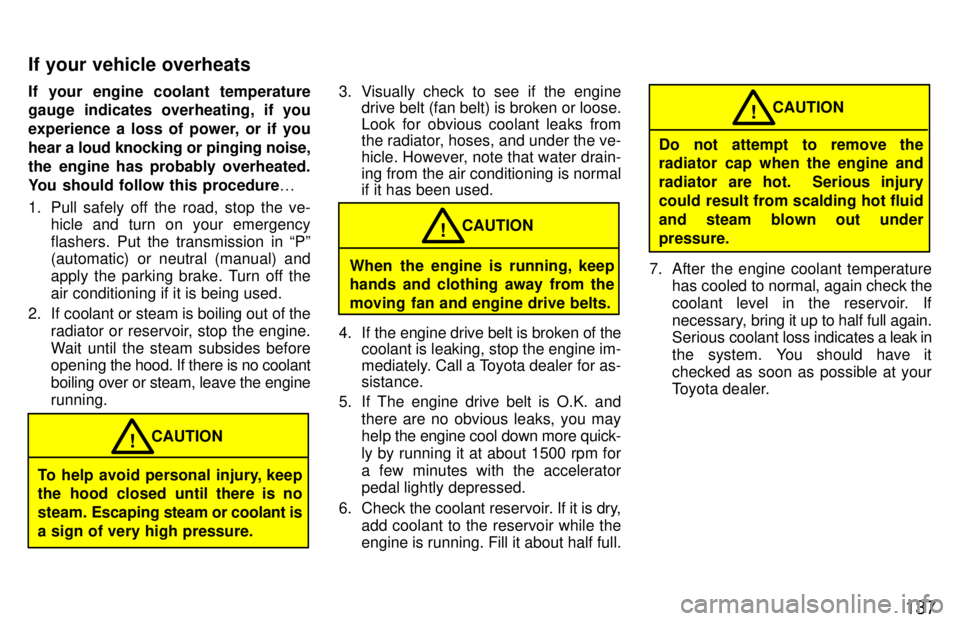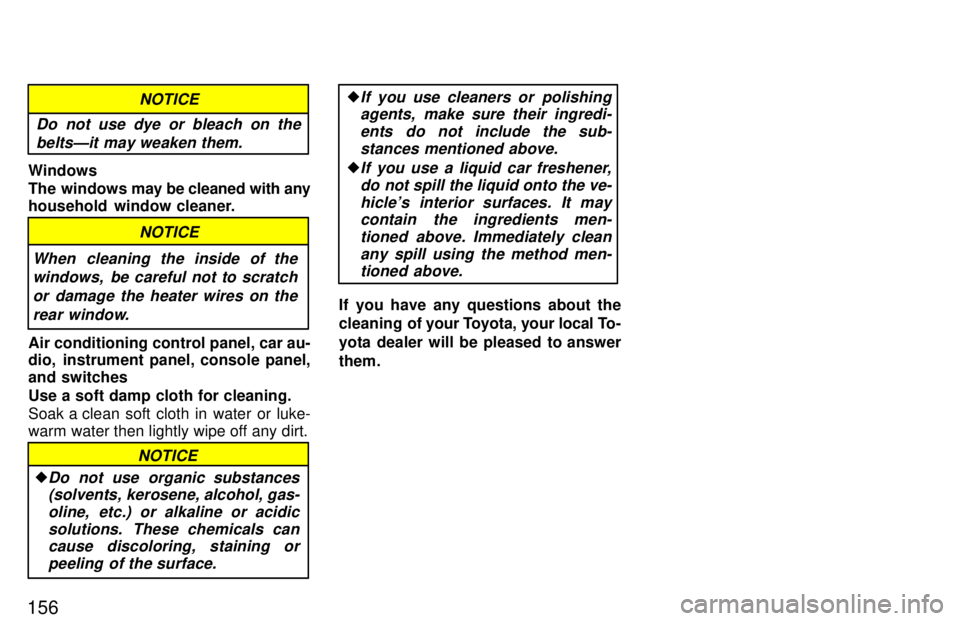Page 141 of 212

137
If your engine coolant temperature
gauge indicates overheating, if you
experience a loss of power, or if you
hear a
loud knocking or pinging noise,
the engine has probably overheated.
You should follow this procedure 0
1. Pull safely off the road, stop the ve- hicle and turn on your emergency
flashers. Put the transmission in Pº
(automatic) or neutral (manual) and
apply the parking brake. Turn off the
air conditioning if it is being used.
2. If coolant or steam is boiling out of the radiator or reservoir, stop the engine.
Wait until the steam subsides before
opening the hood. If there is no coolant
boiling over or steam, leave the engine running.
To help avoid personal injury, keep
the hood closed until there is no steam. Escaping steam or coolant is
a sign of very high pressure. CAUTION
! 3. Visually check to see if the engine
drive belt (fan belt) is broken or loose.
Look for obvious coolant leaks from
the radiator, hoses, and under the ve-
hicle. However, note that water drain-ing from the air conditioning is normal if it has been used.
When the engine is running, keep
hands and clothing away from the
moving fan and engine drive belts. CAUTION
!
4. If the engine drive belt is broken of the coolant is leaking, stop the engine im-
mediately. Call a Toyota dealer for as- sistance.
5. If The engine drive belt is O.K. and there are no obvious leaks, you may
help the engine cool down more quick-
ly by running it at about 1500 rpm for
a few minutes with the accelerator
pedal lightly depressed.
6. Check the coolant reservoir. If it is dry, add coolant to the reservoir while the
engine is running. Fill it about half full.
Do not attempt to remove the
radiator cap when the engine and
radiator are hot. Serious injury
could result from scalding hot fluid
and steam blown out underpressure. CAUTION
!
7. After the engine coolant temperature has cooled to normal, again check the
coolant level in the reservoir. If
necessary, bring it up to half full again.
Serious coolant loss indicates a leak in
the system. You should have it
checked as soon as possible at your
Toyota dealer.
If your vehicle overheats
Page 160 of 212

156
Do not use dye or bleach on thebeltsÐit may weaken them.
NOTICE
Windows
The windows may be cleaned with any
household window cleaner.
When cleaning the inside of the
windows, be careful not to scratch
or damage the heater wires on therear window.
NOTICE
Air conditioning control panel, car au-
dio, instrument panel, console panel,
and switches Use a soft damp cloth for cleaning.
Soak a clean soft cloth in water or luke-
warm water then lightly wipe off any dirt.
�
Do not use organic substances(solvents, kerosene, alcohol, gas-
oline, etc.) or alkaline or acidicsolutions. These chemicals cancause discoloring, staining or
peeling of the surface.
NOTICE
�If you use cleaners or polishingagents, make sure their ingredi-
ents do not include the sub-
stances mentioned above.
�If you use a liquid car freshener,do not spill the liquid onto the ve-
hicle's interior surfaces. It maycontain the ingredients men-
tioned above. Immediately clean
any spill using the method men-tioned above.
If you have any questions about the
cleaning of your Toyota, your local To-
yota dealer will be pleased to answer them.
Page 164 of 212

160Engine coolant level Make sure the coolant level is between
the FULLº and LOWº lines on the see-
through
reservoir when the engine is cold.
See Chapter 7-2 for additional informa-tion when the engine is cold. Battery electrolyte level Make sure the electrolyte level of all bat-
tery cells is between upper and lower level
lines on the case. Add only distilled water
when replenishing. See Chapter 7-3 for
additional information. Brake fluid level
Make sure the brake fluid level is correct. See Chapter 7-2 for additional informa- tion.
Engine oil level
Check the l evel on the dipstick with the en-
gine turned off and the vehicle parked on
a level spot. See Chapter 7-2 for addition-
al information. Power steering fluid level Check the level on the dipstick. The level
should be in the HOTº or COLDº range
depending on the fluid temperature. See Chapter 7-2 for additional information. Exhaust system
If you notice any change in the sound of
the exhaust or smell exhaust fumes, havethe cause located and corrected immedi-
ately. (See engine exhaust cautions in
Part 2.)
Be on the alert for changes in perfor-
mance, sounds, and visual tip-offs
that in-
dicate service is needed. Some important
clues are as follows: � Engine missing, stumbling, or pinging
� Appreciable loss of power
� Strange engine noises
� A leak under the vehicle (however, wa-
ter dripping from the air conditioning
after use is normal.)
� Change in exhaust sound (This may
indicate a dangerous carbon monox-
ide leak. Drive with the windows open
and have the exhaust system checked
immediately.)
� Flat-looking tire; excessive tire squeal
when cornering; uneven tire wear
� Vehicle pulls to one side when driving straight on a level road
� Strange noises related to suspensionmovement
� Loss of brake effectiveness; spongy
feeling brake or clutch pedal; pedal al-
most touches floor; vehicle pulls to one
side when braking
� Engine coolant temperature continual-
ly higher than normal
Does your vehicle need repairing?
Page 204 of 212

200
Fuses (type A)
1. HEAD (LH) 10 A: Left-hand headlight
2. HEAD (RH) 10 A: Right-hand head-
light
3. A/C 10 A: Air conditioning cooling sys-
tem
4 EFI 15 A: Multiport fuel injection sys-
tem/sequential multiport fuel injection
system, electronically controlled auto-
matic transmission system
5. HAZ-HORN 15 A: Emergency flash-
ers, horns
6. DOME 15 A: Interior light, personal
lights, step lights, ignition switch light,
radio, cassette tape player, power an- tenna, clock7. HEAD (LH-HI) 10 A: Left-hand head-
light (high beam)
8. HEAD (RH-HI) 10 A: Right-hand
headlight (high beam)
9. HEAD (LH-LO) 10 A: Left-hand
headlight (low beam)
10. HEAD (RH-LO) 10 A: Right-hand
headlight (low beam)
11. ENGINE 10 A: Charging system,
cruise control system
12. IGN. 7.5 A: Charging system,
discharge warning light, multiport fuel
injection system/sequential multiport fuel injection system13. TAIL 15 A: Tail lights, parking lights,
license plate lights, instrument panel lights, glovebox light
14. WIPER 20 A: Windshield wiper and
washer
15. GAUGES 10 A: Automatic transmis-
sion overdrive control system, gauges
and meters, service reminder indica-
tors and warning buzzers (except dis-
charge cruise warning light), A.D.D. control system, cruise control system,
back-up lights, power door lock sys- tem
16. STOP 15 A: Stop lights, High-
mounted stoplight, cruise control sys-
tem, electronically controlled automat-
ic transmission system
Fuses
Page 205 of 212

201
17. RADIO 7.5 A: Radio, cassette tape
player, power antenna, power rear
view mirrors
18. CIG. 15 A: Cigarette lighter, digital
clock display, shift lick control system(automatic transmission)
19. TURN 10 A: Turn signal lights, emer-
gency flashers
20. ECU-B 15 A: Anti-lock brake system,
SRS airbag system, cruise control
system, daytime running light system
21. DRL 7.5 A: Daytime running light sys-
tem
22. ECU-IG 20 A: Anti-lock brake sys-
tem, cruise control system 23. OBD 2 7.5 A:
On-board diagnosis
system
Fuses (type B)
24.AM1 40 A: Starting system, all compo-
nents in ENGINEº, IGNº, WIPERº,
GAUGESº. RADIOº, CIG.º, TURNº
and PWRº fuses
25. AM2 340 A: Starting system, all com-
ponents in ENGINEº, IGN.º, WIP-
ERº, GAUGESº, RADIOº, CIG.º and
TURNº fuses
26 HEATER 40 A: Air conditioning heat-
ing system
27. PWR 30 A: Power door lock system,
power windows
Fuse (type C)
28. ABS 60 A: Anti-lock brake system
29. ALT 100 A: All components in A/Cº,
TAILº, STOPº, ECU-Bº, AM1º and
HEATERº fuses